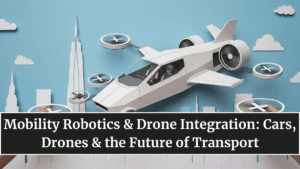The line between vehicles, robots, and drones is rapidly disappearing. In 2025, the world is witnessing a new revolution — mobility robotics and drone integration — where cars, aerial drones, and autonomous robots collaborate to form intelligent, interconnected transport ecosystems.
From self-driving delivery vans launching drones mid-route to AI-controlled robotic couriers navigating sidewalks, this fusion of technologies is transforming logistics, emergency response, and urban mobility. It’s not science fiction anymore — it’s the next evolution of transportation.

The Concept of Mobility Robotics
Mobility robotics refers to the convergence of autonomous vehicles, ground robots, and aerial drones designed to move people or goods efficiently through shared digital networks. These systems communicate with each other through 5G, V2X (Vehicle-to-Everything), and AI orchestration platforms, creating a synchronized flow of intelligent mobility.
In simpler terms, your future car might not just drive itself — it might deploy a delivery drone, coordinate with warehouse robots, or even guide rescue drones during emergencies.
Real-World Examples of Integration
The integration of robotics and drones into mobility ecosystems is already underway across several industries:
-
Amazon Prime Air & Rivian Vans: Delivery vans equipped with onboard drone pods to perform last-mile deliveries in rural areas.
-
UPS Flight Forward: Combining electric trucks and drones to cut logistics time for medical supplies.
-
Nuro & Kiwibot: Using ground robots for autonomous food and parcel delivery across U.S. campuses.
-
Mahindra Logistics & Skye Air (India): Developing hybrid logistics where road vehicles and delivery drones share navigation data for faster delivery.
-
Hyundai Urban Air Mobility Division: Working on integrated car-drone mobility hubs for urban air taxis and autonomous ground shuttles.
Each of these initiatives aims to reduce delivery time, lower emissions, and expand accessibility — key to future smart-city planning.
How Drone-Vehicle Integration Works
Drone-vehicle integration relies on three key components:
-
Smart Docking Systems
Vehicles are equipped with automated drone bays that can launch or retrieve drones during motion or stops. -
Real-Time Data Synchronization
Using 5G and edge computing, vehicles and drones exchange live navigation and sensor data to avoid collisions and optimize routes. -
AI Command Platforms
Artificial intelligence coordinates which unit — car, drone, or robot — handles which part of the journey, based on terrain, distance, and urgency.
For example, a courier van may cover the highway segment, while drones handle last-mile delivery to rooftops or isolated houses.
Applications Transforming Mobility
1. Logistics & E-Commerce
Autonomous delivery pods and drones reduce congestion and emissions while increasing delivery efficiency. They allow companies to serve areas where conventional vehicles struggle to reach.
2. Emergency & Disaster Response
Drones integrated with rescue vehicles can scan disaster zones, deliver medical kits, and share thermal imaging in real time, speeding up search and rescue missions.
3. Urban Mobility & Commuting
Air taxis, autonomous pods, and robotic parking systems work together to optimize urban space and traffic management.
4. Agriculture & Rural Transport
Ground robots and drones coordinate to transport supplies, monitor crops, and manage field logistics efficiently in rural areas.
India’s Role in Mobility Robotics
India’s auto-tech sector is fast entering this new domain. DRDO, IITs, and private EV startups are testing AI-based drone-vehicle communication systems for:
-
Medical supply delivery in hilly and remote regions.
-
Smart logistics for e-commerce in Tier-2 and Tier-3 cities.
-
Autonomous traffic management in smart-city corridors.
With government support under the Drone Rules 2021 and Make in India policies, India is positioning itself as a future hub for integrated autonomous mobility.
Key Benefits of Integration
-
Speed & Efficiency: Combined use of air and ground mobility reduces delivery time by up to 40%.
-
Lower Emissions: Electric drones and robots decrease carbon footprints.
-
Cost Optimization: Reduces human dependency and logistics overhead.
-
Safety & Precision: AI coordination ensures accuracy in navigation and delivery.
-
Accessibility: Expands transport solutions to rural and disaster-prone regions.
These advantages underline how mobility robotics could redefine not just transportation — but the entire urban experience.
Challenges and Limitations
Despite the innovation, a few hurdles remain:
-
Regulatory gaps: Airspace laws for drones and autonomous vehicles are still evolving.
-
Security & privacy: Integrated systems require strong cybersecurity measures.
-
High infrastructure cost: Requires investment in smart roads, charging stations, and drone docks.
-
Public acceptance: Safety concerns still influence adoption rates.
Policymakers and companies are now working together to build AI-governed frameworks ensuring responsible, safe deployment of these technologies.
The Road Ahead: Autonomous Ecosystems
By 2030, mobility ecosystems will likely include connected drones, self-driving cars, and AI logistics hubs working as a single network. Key trends shaping the future include:
-
AI-coordinated traffic systems for drones and ground vehicles.
-
Modular robotic fleets adaptable for cargo or passenger use.
-
Urban air corridors for short-range aerial transport.
-
Hybrid energy systems using solar and wireless charging for autonomous fleets.
The dream is a city where goods and people flow seamlessly, with zero emissions and minimal human intervention.
FAQs
What is mobility robotics?
Mobility robotics refers to the combination of autonomous ground vehicles, drones, and robots working together for transport and logistics.
How do drones integrate with cars?
Drones can launch from or sync with vehicles to handle last-mile delivery, using AI and 5G-based control systems.
Which industries benefit most from this integration?
Logistics, emergency response, e-commerce, agriculture, and smart-city transport see the biggest gains.
Is India involved in developing such technologies?
Yes. Indian tech firms, IITs, and logistics startups are testing AI-based drone-vehicle systems for deliveries and medical transport.
What’s the biggest challenge for drone-vehicle integration?
Ensuring regulatory approval, data security, and safe coordination across mixed air-ground traffic environments.
Click here to know more.
